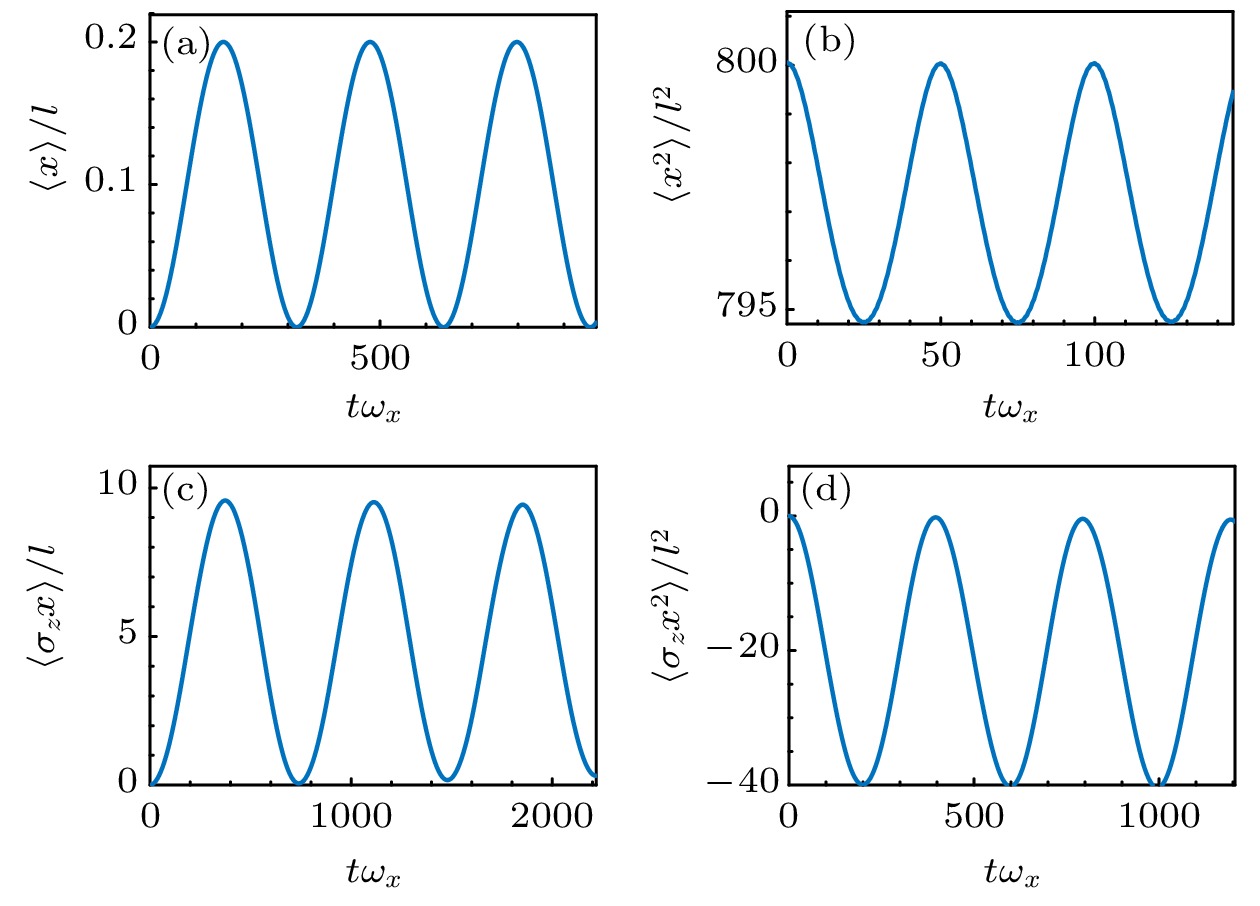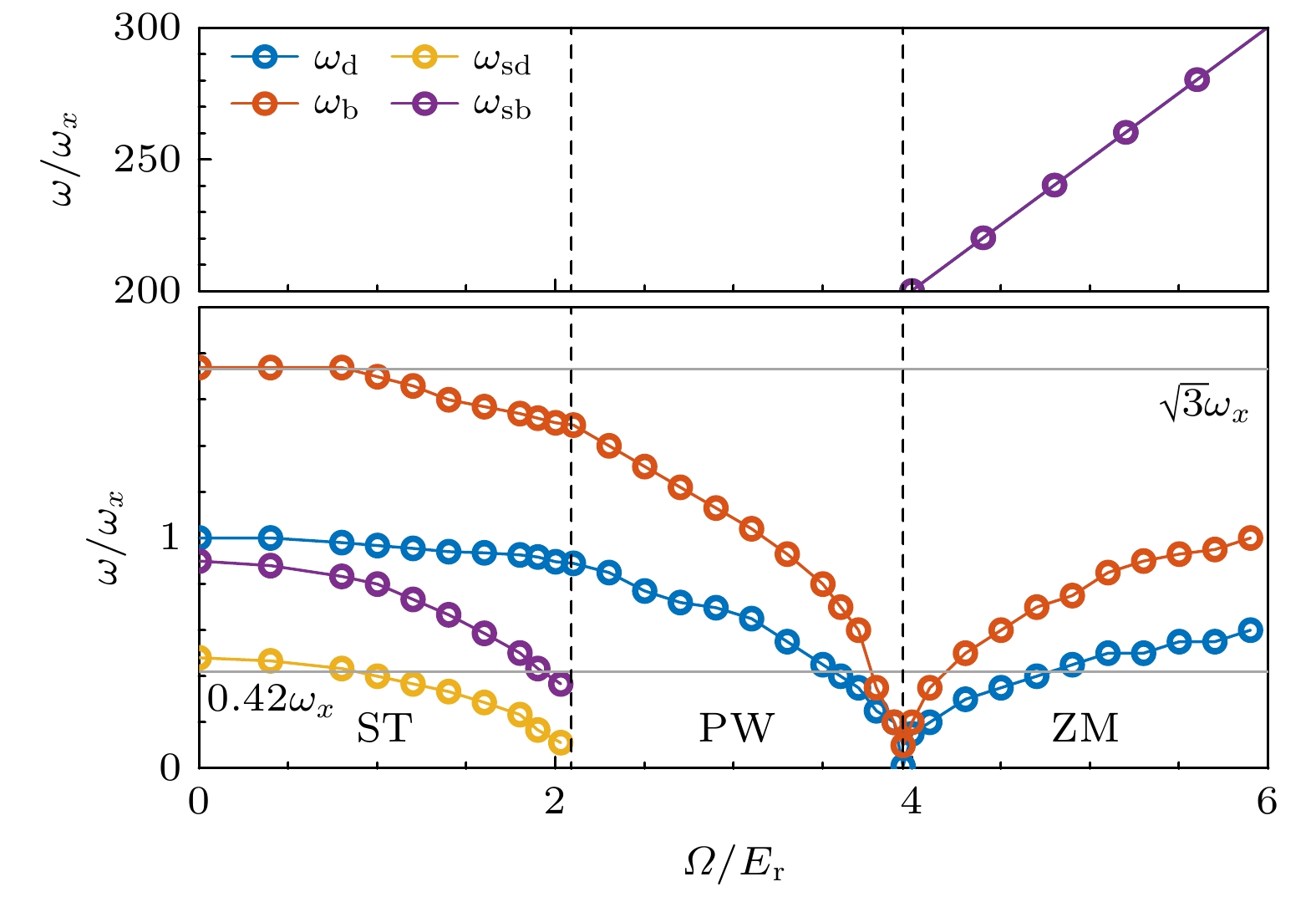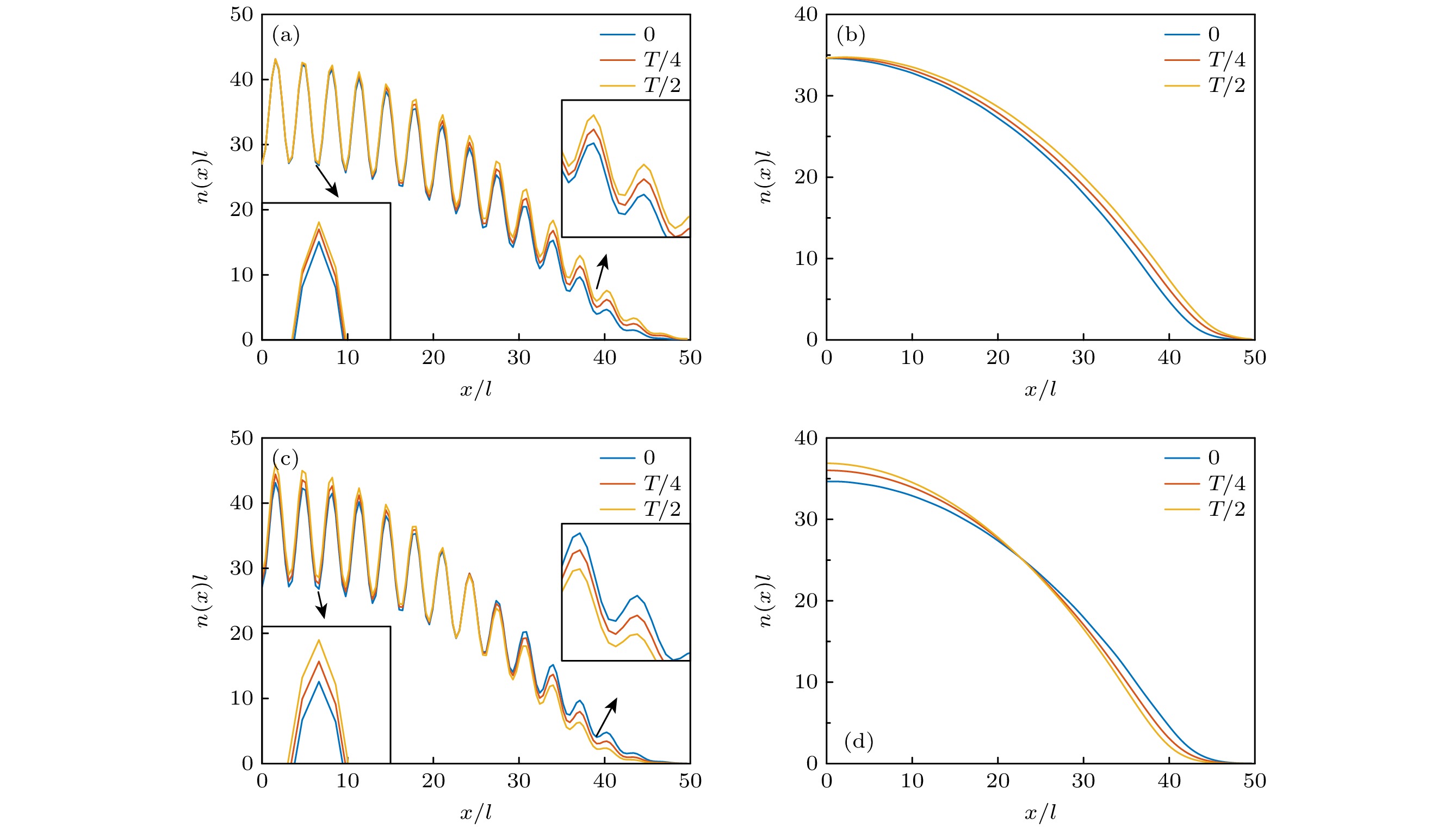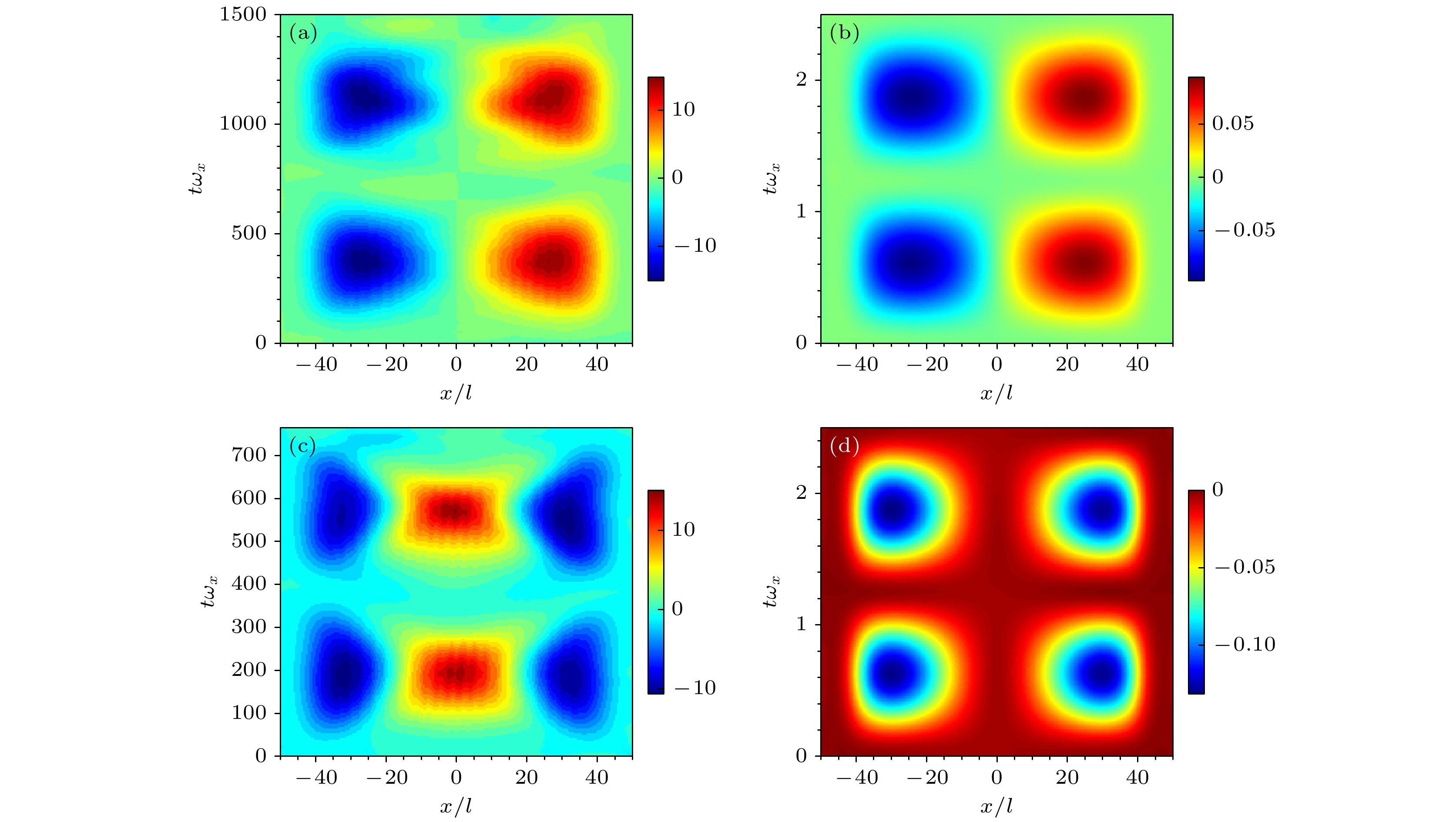-
基于数值求解定态与含时Gross-Pitaevskii方程, 本文研究了一维拉曼型自旋-轨道耦合玻色气体中的静态特性与低能集体激发动力学性质. 分析了凝聚体动量、自旋极化率和基态能量来分类三种基态物相(条纹相、平面波相和零动量相)以及对应的相变. 在此基础上, 通过设计不同的微扰激发方式, 重点研究了四种典型的低能集体激发模式(偶极、呼吸、自旋-偶极和自旋-呼吸模式)的频率特性和动力学行为. 结果发现, 四种模式频率随拉比频率增加呈现非单调变化行为且不同物相中的集体激发模式表现出显著差异, 尤其是自旋相关的两种模式在条纹相中呈现自旋自由度相关的独特振荡行为. 这些发现将为理解自旋-轨道耦合玻色气体中新奇物相的量子多体动力学提供重要参考和理论依据.The ground-state properties and collective excitations in a weakly interacting Bose gas with Raman-type spin-orbit coupling in one dimension are systematically investigated by numerically solving static and time-dependent Gross-Pitaevskii equations in this work. Our analysis focuses on three different quantum phases, i.e., stripe phase, plane-wave phase, and zero-momentum phase, which are characterized by key static properties including condensate momentum, spin polarization, and ground-state energy. The dynamic behaviors of total-density collective modes, i.e., the dipole mode that drives harmonic oscillations of the atomic cloud's center of mass and the breathing mode that is responsible for periodic expansion and contraction of density profile, are all explored using time-dependent simulations. Mode frequencies exhibit non-monotonic dependence on Rabi frequency in the three phases, and are significantly suppressed at the transition point between the plane-wave and the zero-momentum phases. Additionally, the spin-dependent collective excitations, particularly the spin-dipole and spin-breathing modes, are studied, which are governed by the time-dependent spin density distribution $(\delta n(x, t) \equiv n_\uparrow(x, t)-n_\downarrow(x, t)\,)$ as shown in the following figure. The results indicate that two spin oscillation modes exist only in the stripe phase and the zero-momentum phase, with the latter exhibiting substantially higher frequencies. Notably, mode frequencies decrease monotonically with the increase of Rabi frequency in the stripe phase, whereas they rise linearly in the zero-momentum phase. The spin-dipole mode induces rigid, out-of-phase oscillations of the two spin components, while the spin-breathing mode modulates the spin density distribution periodically. These findings offer fundamental theoretical insights into the dynamic behaviors of spin-orbit-coupled quantum gases, particularly regarding spin-related collective excitations, and provide valuable guidance for future cold-atom experiments.
[1] Bloch I, Dalibard J, Zwerger W 2008 Rev. Mod. Phys. 80 885
 Google Scholar
Google Scholar
[2] Dalibard J, Gerbier F, Juzeliūnas G, Öhberg P 2011 Rev. Mod. Phys. 83 1523
 Google Scholar
Google Scholar
[3] Goldman N, Juzeliūnas G, Öhberg P, Spielman I B 2014 Rep. Prog. Phys. 77 126401
 Google Scholar
Google Scholar
[4] Lin Y J, Jiménez-García K, Spielman I B 2011 Nature 471 83
 Google Scholar
Google Scholar
[5] Wang P, Yu Z Q, Fu Z, Miao J, Huang L, Chai S, Zhai H, Zhang J 2012 Phys. Rev. Lett. 109 095301
 Google Scholar
Google Scholar
[6] Cheuk L W, Sommer A T, Hadzibabic Z, Yefsah T, Bakr W S, Zwierlein M W 2012 Phys. Rev. Lett. 109 095302
 Google Scholar
Google Scholar
[7] Wu Z, Zhang L, Sun W, Xu X T, Wang B Z, Ji S C, Deng Y, Chen S, Liu X J, Pan J W 2016 Science 354 83
 Google Scholar
Google Scholar
[8] Huang L, Meng Z, Wang P, Peng P, Zhang S L, Chen L, Li D, Zhou Q, Zhang J 2016 Nat. Phys. 12 540
 Google Scholar
Google Scholar
[9] Chen H R, Lin K Y, Chen P K, Chiu N C, Wang J B, Chen C A, Huang P, Yip S K, Kawaguchi Y, Lin Y J 2018 Phys. Rev. Lett. 121 113204
 Google Scholar
Google Scholar
[10] Zhang D, Gao T, Zou P, Kong L, Li R, Shen X, Chen X L, Peng S G, Zhan M, Pu H, Jiang K 2019 Phys. Rev. Lett. 122 110402
 Google Scholar
Google Scholar
[11] Wang Z Y, Cheng X C, Wang B Z, Zhang J Y, Lu Y H, Yi C R, Niu S, Deng Y, Liu X J, Chen S, Pan J W 2021 Science 372 271
[12] Galitski V, Spielman I B 2013 Nature 494 49
[13] Zhai H 2015 Rep. Prog. Phys. 78 026001
 Google Scholar
Google Scholar
[14] Wang C, Gao C, Jian C M, Zhai H 2010 Phys. Rev. Lett. 105 160403
 Google Scholar
Google Scholar
[15] Ho T L, Zhang S 2011 Phys. Rev. Lett. 107 150403
 Google Scholar
Google Scholar
[16] Li Y, Pitaevskii L P, Stringari S 2012 Phys. Rev. Lett. 108 225301
 Google Scholar
Google Scholar
[17] Hu H, Ramachandhran B, Pu H, Liu X J 2012 Phys. Rev. Lett. 108 010402
 Google Scholar
Google Scholar
[18] Gong M, Tewari S, Zhang C 2011 Phys. Rev. Lett. 107 195303
 Google Scholar
Google Scholar
[19] Hu H, Jiang L, Liu X J, Pu H 2011 Phys. Rev. Lett. 107 195304
 Google Scholar
Google Scholar
[20] Yu Z Q, Zhai H 2011 Phys. Rev. Lett. 107 195305
 Google Scholar
Google Scholar
[21] Zhang J Y, Ji S C, Chen Z, Zhang L, Du Z D, Yan B, Pan G S, Zhao B, Deng Y J, Zhai H, Chen S, Pan J W 2012 Phys. Rev. Lett. 109 115301
 Google Scholar
Google Scholar
[22] Khamehchi M A, Zhang Y, Hamner C, Busch T, Engels P 2014 Phys. Rev. A 90 063624
 Google Scholar
Google Scholar
[23] Ji S C, Zhang J Y, Zhang L, Du Z D, Zheng W, Deng Y J, Zhai H, Chen S, Pan J W 2014 Nat. Phys. 10 314
 Google Scholar
Google Scholar
[24] Ji S C, Zhang L, Xu X T, Wu Z, Deng Y, Chen S, Pan J W 2015 Phys. Rev. Lett. 114 105301
 Google Scholar
Google Scholar
[25] Zhu Q, Zhang C, Wu B 2012 EPL 100 50003
 Google Scholar
Google Scholar
[26] Zhang Y C, Yu Z Q, Ng T K, Zhang S, Pitaevskii L, Stringari S 2016 Phys. Rev. A 94 033635
 Google Scholar
Google Scholar
[27] Yu Z Q 2017 Phys. Rev. A 95 033618
 Google Scholar
Google Scholar
[28] Chen X L, Wang J, Li Y, Liu X J, Hu H 2018 Phys. Rev. A 98 013614
 Google Scholar
Google Scholar
[29] Chen X L, Liu X J, Hu H 2022 Phys. Rev. A 106 023302
 Google Scholar
Google Scholar
[30] Meng Z, Huang L, Peng P, Li D, Chen L, Xu Y, Zhang C, Wang P, Zhang J 2016 Phys. Rev. Lett. 117 235304
 Google Scholar
Google Scholar
[31] Sun W, Yi C R, Wang B Z, Zhang W W, Sanders B C, Xu X T, Wang Z Y, Schmiedmayer J, Deng Y, Liu X J, Chen S, Pan J W 2018 Phys. Rev. Lett. 121 250403
 Google Scholar
Google Scholar
[32] Zhang J Y, Yi C R, Zhang L, Jiao R H, Shi K Y, Yuan H, Zhang W, Liu X J, Chen S, Pan J W 2023 Phys. Rev. Lett. 130 043201
 Google Scholar
Google Scholar
[33] Martone G I, Li Y, Pitaevskii L P, Stringari S 2012 Phys. Rev. A 86 063621
 Google Scholar
Google Scholar
[34] Zheng W, Yu Z Q, Cui X, Zhai H 2013 J. Phys. B: At. Mol. Opt. Phys. 46 134007
 Google Scholar
Google Scholar
[35] Chen X L, Liu X J, Hu H 2017 Phys. Rev. A 96 013625
 Google Scholar
Google Scholar
[36] Chen L, Pu H, Yu Z Q, Zhang Y 2017 Phys. Rev. A 95 033616
 Google Scholar
Google Scholar
[37] Rajat, Roy A, Gautam S 2022 Phys. Rev. A 106 013304
 Google Scholar
Google Scholar
[38] Liang J C, Zhang A X, Xue J K 2024 Phys. Rev. A 109 053307
 Google Scholar
Google Scholar
[39] Li J R, Lee J, Huang W, Burchesky S, Shteynas B, Top F Ç, Jamison A O, Ketterle W 2017 Nature 543 91
 Google Scholar
Google Scholar
[40] Léonard J, Morales A, Zupancic P, Esslinger T, Donner T 2017 Nature 543 87
 Google Scholar
Google Scholar
[41] Geier K T, Martone G I, Hauke P, Stringari S 2021 Phys. Rev. Lett. 127 115301
 Google Scholar
Google Scholar
[42] Geier K T, Martone G I, Hauke P, Ketterle W, Stringari S 2023 Phys. Rev. Lett. 130 156001
 Google Scholar
Google Scholar
[43] Li Y, Martone G I, Stringari S 2012 EPL 99 56008
 Google Scholar
Google Scholar
[44] Sartori A, Marino J, Stringari S, Recati A 2015 New J. Phys. 17 093036
 Google Scholar
Google Scholar
[45] Bienaimé T, Fava E, Colzi G, Mordini C, Serafini S, Qu C, Stringari S, Lamporesi G, Ferrari G 2016 Phys. Rev. A 94 063652
 Google Scholar
Google Scholar
[46] Fava E, Bienaimé T, Mordini C, Colzi G, Qu C, Stringari S, Lamporesi G, Ferrari G 2018 Phys. Rev. Lett. 120 170401
 Google Scholar
Google Scholar
[47] Dalfovo F, Giorgini S, Pitaevskii L P, Stringari S 1999 Rev. Mod. Phys. 71 463
 Google Scholar
Google Scholar
[48] Menotti C, Stringari S 2002 Phys. Rev. A 66 043610
 Google Scholar
Google Scholar
[49] Pitaevskii L, Stringari S 2016 Bose-Einstein Condensation and Superfluidity (Oxford: Oxford University Press) p406
-
图 1 拉曼型自旋-轨道耦合玻色气体三种基态物相 ST, PW 以及 ZM 中 (a)凝聚体动量$ P_x $; (b) 自旋极化率$ \langle\sigma_z\rangle $; (c)能量E, 随拉比频率Ω的变化行为. (a)中插图表示各物相中典型密度分布, 其中蓝色实线、红色虚线分别表示自旋向上和自旋向下组分的密度分布. (c)中插图为帮助判断相变类型的能量关于拉比频率的导数$ {\mathrm{d}}E/{\mathrm{d}}\varOmega $. 图中竖划线和竖点线分别表示本文理论框架确定的ST-PW和PW-ZM相变点处拉比频率$ 2.08 E_{\rm{r}} $和$ 3.95 E_{\rm{r}} $.
Fig. 1. (a) The condensate momentum $ P_x $, (b) the spin polarization $ \langle\sigma_z\rangle $, and (c) the energy E in the ST, PW, and ZM phases, as functions of the Rabi frequency Ω in the Raman-type spin-orbit coupled Bose gases. The insets in (a) denote the typical density distribution in respective phases, where the density distributions of the spin-up and spin-down components are indicated by the blue-solid and red-dashed lines, respectively. The insets in (c) denote the derivative of the energy with respect to the Rabi frequency $ {\mathrm{d}}E/{\mathrm{d}}\varOmega $ to determine the type of phase transitions. The vertical dashed and dotted lines indicate the critical Rabi frequencies of the ST-PW and PW-ZM phase transitions, respectively, determined by our numerical calculations.
图 4 偶极模式(第一行)和呼吸模式(第二行)中的典型密度动力学特征 (a), (c) $ \varOmega=1.0 E_{\mathrm{r}} $处的条纹相; (b), (d) $ \varOmega=3.0 E_{\mathrm{r}} $处的平面波相. 其中, 三种颜色线分别表示$ 0, \;T/4,\; T/2 $三个时间点的密度分布
Fig. 4. Typical density evolution of dipole-mode (top panel) and breathing-mode (bottom panel) oscillations: (a), (c) Stripe phase at $ \varOmega=1.0 E_{\mathrm{r}} $; (b), (d) plane-wave phase at $ \varOmega=3.0 E_{\mathrm{r}} $. Here, three colorful lines indicate the density distributions at $ 0 $, $ T/4 $, and $ T/2 $ of one full period T.
图 7 自旋-偶极模式(第一行)和自旋-呼吸模式(第二行)中自旋密度分布$ {\text{δ}} n(x, t)\equiv n_\uparrow(x, t)-n_\downarrow(x, t) $的t-x平面等高图 (a), (c) $ \varOmega=1.0 E_{\mathrm{r}} $处的条纹相; (b), (d) $ \varOmega=5.0 E_{\mathrm{r}} $处的零动量相. (a)—(d)中色条表示范围分别为: [–15, 15], [–0.1, 0.1], [–10, 15], [–0.14, 0]
Fig. 7. Contour plots of time-dependent spin density $ {\text{δ}} n(x, t)\equiv n_\uparrow(x, t)-n_\downarrow(x, t) $ of spin-dipole mode (top panel) and spin-breathing mode (bottom panel) in the t-x plane: (a), (c) Stripe phase at $ \varOmega=1.0 E_{\mathrm{r}} $; (b), (d) zero-momentum phase at $ \varOmega=5.0 E_{\mathrm{r}} $. Color scales: (a) –15 to 15; (b) –0.1 to 0.1; (c) –10 to 15; (d) –0.14 to 0.
表 1 四种集体激发模式(偶极, 呼吸, 自旋-偶极, 自旋-呼吸)所对应的激发方式以及观测量. 其中, x0和α均为小量以使得系统被微弱地扰动
Table 1. Exciting approaches and observables for four collective excitation modes, including dipole mode, breathing mode, spin-dipole mode, and spin-breathing mode. Here, x0 and α are both small enough to perturb the systems slightly.
集体激发模式 $ V_1(x) $ 物理观测量 偶极模式 $ \dfrac{1}{2} m\omega_x^{2} (x-x_0)^2 $ $ \left\langle x\right\rangle $ 呼吸模式 $ \dfrac{1}{2} m(1+\alpha )^2\omega_x^{2} x^2 $ $ \left\langle x^2\right\rangle $ 自旋-偶极模式 $ \dfrac{1}{2} m\omega_x^{2} (x-\sigma_{z}x_0)^2 $ $ \left\langle\sigma_{z}x \right\rangle $ 自旋-呼吸模式 $ \dfrac{1}{2} m(1+\sigma_{z} \alpha )^2\omega_x^{2} x^2 $ $ \left\langle\sigma_{z}x^2\right\rangle $ -
[1] Bloch I, Dalibard J, Zwerger W 2008 Rev. Mod. Phys. 80 885
 Google Scholar
Google Scholar
[2] Dalibard J, Gerbier F, Juzeliūnas G, Öhberg P 2011 Rev. Mod. Phys. 83 1523
 Google Scholar
Google Scholar
[3] Goldman N, Juzeliūnas G, Öhberg P, Spielman I B 2014 Rep. Prog. Phys. 77 126401
 Google Scholar
Google Scholar
[4] Lin Y J, Jiménez-García K, Spielman I B 2011 Nature 471 83
 Google Scholar
Google Scholar
[5] Wang P, Yu Z Q, Fu Z, Miao J, Huang L, Chai S, Zhai H, Zhang J 2012 Phys. Rev. Lett. 109 095301
 Google Scholar
Google Scholar
[6] Cheuk L W, Sommer A T, Hadzibabic Z, Yefsah T, Bakr W S, Zwierlein M W 2012 Phys. Rev. Lett. 109 095302
 Google Scholar
Google Scholar
[7] Wu Z, Zhang L, Sun W, Xu X T, Wang B Z, Ji S C, Deng Y, Chen S, Liu X J, Pan J W 2016 Science 354 83
 Google Scholar
Google Scholar
[8] Huang L, Meng Z, Wang P, Peng P, Zhang S L, Chen L, Li D, Zhou Q, Zhang J 2016 Nat. Phys. 12 540
 Google Scholar
Google Scholar
[9] Chen H R, Lin K Y, Chen P K, Chiu N C, Wang J B, Chen C A, Huang P, Yip S K, Kawaguchi Y, Lin Y J 2018 Phys. Rev. Lett. 121 113204
 Google Scholar
Google Scholar
[10] Zhang D, Gao T, Zou P, Kong L, Li R, Shen X, Chen X L, Peng S G, Zhan M, Pu H, Jiang K 2019 Phys. Rev. Lett. 122 110402
 Google Scholar
Google Scholar
[11] Wang Z Y, Cheng X C, Wang B Z, Zhang J Y, Lu Y H, Yi C R, Niu S, Deng Y, Liu X J, Chen S, Pan J W 2021 Science 372 271
[12] Galitski V, Spielman I B 2013 Nature 494 49
[13] Zhai H 2015 Rep. Prog. Phys. 78 026001
 Google Scholar
Google Scholar
[14] Wang C, Gao C, Jian C M, Zhai H 2010 Phys. Rev. Lett. 105 160403
 Google Scholar
Google Scholar
[15] Ho T L, Zhang S 2011 Phys. Rev. Lett. 107 150403
 Google Scholar
Google Scholar
[16] Li Y, Pitaevskii L P, Stringari S 2012 Phys. Rev. Lett. 108 225301
 Google Scholar
Google Scholar
[17] Hu H, Ramachandhran B, Pu H, Liu X J 2012 Phys. Rev. Lett. 108 010402
 Google Scholar
Google Scholar
[18] Gong M, Tewari S, Zhang C 2011 Phys. Rev. Lett. 107 195303
 Google Scholar
Google Scholar
[19] Hu H, Jiang L, Liu X J, Pu H 2011 Phys. Rev. Lett. 107 195304
 Google Scholar
Google Scholar
[20] Yu Z Q, Zhai H 2011 Phys. Rev. Lett. 107 195305
 Google Scholar
Google Scholar
[21] Zhang J Y, Ji S C, Chen Z, Zhang L, Du Z D, Yan B, Pan G S, Zhao B, Deng Y J, Zhai H, Chen S, Pan J W 2012 Phys. Rev. Lett. 109 115301
 Google Scholar
Google Scholar
[22] Khamehchi M A, Zhang Y, Hamner C, Busch T, Engels P 2014 Phys. Rev. A 90 063624
 Google Scholar
Google Scholar
[23] Ji S C, Zhang J Y, Zhang L, Du Z D, Zheng W, Deng Y J, Zhai H, Chen S, Pan J W 2014 Nat. Phys. 10 314
 Google Scholar
Google Scholar
[24] Ji S C, Zhang L, Xu X T, Wu Z, Deng Y, Chen S, Pan J W 2015 Phys. Rev. Lett. 114 105301
 Google Scholar
Google Scholar
[25] Zhu Q, Zhang C, Wu B 2012 EPL 100 50003
 Google Scholar
Google Scholar
[26] Zhang Y C, Yu Z Q, Ng T K, Zhang S, Pitaevskii L, Stringari S 2016 Phys. Rev. A 94 033635
 Google Scholar
Google Scholar
[27] Yu Z Q 2017 Phys. Rev. A 95 033618
 Google Scholar
Google Scholar
[28] Chen X L, Wang J, Li Y, Liu X J, Hu H 2018 Phys. Rev. A 98 013614
 Google Scholar
Google Scholar
[29] Chen X L, Liu X J, Hu H 2022 Phys. Rev. A 106 023302
 Google Scholar
Google Scholar
[30] Meng Z, Huang L, Peng P, Li D, Chen L, Xu Y, Zhang C, Wang P, Zhang J 2016 Phys. Rev. Lett. 117 235304
 Google Scholar
Google Scholar
[31] Sun W, Yi C R, Wang B Z, Zhang W W, Sanders B C, Xu X T, Wang Z Y, Schmiedmayer J, Deng Y, Liu X J, Chen S, Pan J W 2018 Phys. Rev. Lett. 121 250403
 Google Scholar
Google Scholar
[32] Zhang J Y, Yi C R, Zhang L, Jiao R H, Shi K Y, Yuan H, Zhang W, Liu X J, Chen S, Pan J W 2023 Phys. Rev. Lett. 130 043201
 Google Scholar
Google Scholar
[33] Martone G I, Li Y, Pitaevskii L P, Stringari S 2012 Phys. Rev. A 86 063621
 Google Scholar
Google Scholar
[34] Zheng W, Yu Z Q, Cui X, Zhai H 2013 J. Phys. B: At. Mol. Opt. Phys. 46 134007
 Google Scholar
Google Scholar
[35] Chen X L, Liu X J, Hu H 2017 Phys. Rev. A 96 013625
 Google Scholar
Google Scholar
[36] Chen L, Pu H, Yu Z Q, Zhang Y 2017 Phys. Rev. A 95 033616
 Google Scholar
Google Scholar
[37] Rajat, Roy A, Gautam S 2022 Phys. Rev. A 106 013304
 Google Scholar
Google Scholar
[38] Liang J C, Zhang A X, Xue J K 2024 Phys. Rev. A 109 053307
 Google Scholar
Google Scholar
[39] Li J R, Lee J, Huang W, Burchesky S, Shteynas B, Top F Ç, Jamison A O, Ketterle W 2017 Nature 543 91
 Google Scholar
Google Scholar
[40] Léonard J, Morales A, Zupancic P, Esslinger T, Donner T 2017 Nature 543 87
 Google Scholar
Google Scholar
[41] Geier K T, Martone G I, Hauke P, Stringari S 2021 Phys. Rev. Lett. 127 115301
 Google Scholar
Google Scholar
[42] Geier K T, Martone G I, Hauke P, Ketterle W, Stringari S 2023 Phys. Rev. Lett. 130 156001
 Google Scholar
Google Scholar
[43] Li Y, Martone G I, Stringari S 2012 EPL 99 56008
 Google Scholar
Google Scholar
[44] Sartori A, Marino J, Stringari S, Recati A 2015 New J. Phys. 17 093036
 Google Scholar
Google Scholar
[45] Bienaimé T, Fava E, Colzi G, Mordini C, Serafini S, Qu C, Stringari S, Lamporesi G, Ferrari G 2016 Phys. Rev. A 94 063652
 Google Scholar
Google Scholar
[46] Fava E, Bienaimé T, Mordini C, Colzi G, Qu C, Stringari S, Lamporesi G, Ferrari G 2018 Phys. Rev. Lett. 120 170401
 Google Scholar
Google Scholar
[47] Dalfovo F, Giorgini S, Pitaevskii L P, Stringari S 1999 Rev. Mod. Phys. 71 463
 Google Scholar
Google Scholar
[48] Menotti C, Stringari S 2002 Phys. Rev. A 66 043610
 Google Scholar
Google Scholar
[49] Pitaevskii L, Stringari S 2016 Bose-Einstein Condensation and Superfluidity (Oxford: Oxford University Press) p406
计量
- 文章访问数: 825
- PDF下载量: 47
- 被引次数: 0














 下载:
下载:






